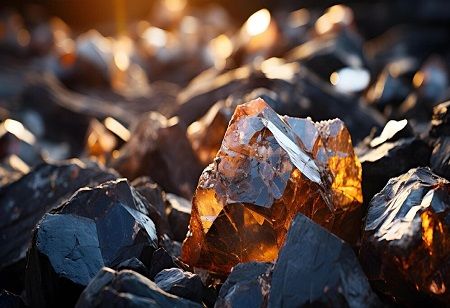
By 2047, the mining industry in the state of Rajasthan is anticipated to witness significant growth, offering employment to over 10 million people both directly & indirectly, with projections displaying a tripling of mining lease areas to over seven thousand square kilometers & increasing government revenue threefold to Rs 25000 crore.
Shri Bhagwati Prasad Kalal, Director, Mining & Geology Department, Udaipur emphasized the importance of adopting zero-loss mining techniques, developing mineral-based clusters, and incorporating the latest technologies.
He also mentioned that “private participation in mineral exploration will be determined, and efforts will be made to minimise mineral imports. The mining sector currently provides direct employment to 7-8 lakh people and indirect employment to 25 -28 lakh people in the state, with immense opportunities for growth”
The industrial minerals sector which comprises the extraction & processing of minerals which include clay, limestone, silica is the cornerstone of modern industry. This industry has undergone huge transformation owing to the introduction of digitalization & automation. These advancements have resulted in significant enhancements in safety, sustainability & efficiency reshaping the mineral extraction & processing segment.
Efficiency and productivity gains
The substantial increase in efficiency as well as productivity is one of the most profound impacts of digitalization & automation in the industrial minerals industry. Robotics & automated machinery have revolutionized mineral extraction. This has resulted in decreasing the need for manual labor which has led to enablement of continuous operation. For example, autonomous drilling & hauling system can now operate 24x7 and this has led to drastically improve the output & reduce downtime. IoT devices & sensors – the digital tools offer real-time data on mineral quality & equipment performance, which allows for immediate adjustments & optimizations in the process of production.
“The mineral extraction industry has grown significantly because of different causes, such as improved mining technology and infrastructure and increased demand from the global market due to industrialization and infrastructure developments,” says Lalit M Gupta, Director, Radha Krishna Corporation.
“Furthermore, efficient mining technologies have been enhanced through investment in infrastructural activities,” he adds.
Predictive maintenance which is powered by Artificial Intelligence and machine learning by anticipating equipment failures even before they occur help in improving productivity. This not only helps in decreasing unexpected downtime but also extends the machinery’s lifespan. For instance, preemptive repairs & production interruptions can be reduced through vibration analysis & thermal imaging which can predict bearing failures in conveyors & crushers.
Safety Improvements
Through automation & digitization, safety in the industrial minerals industry has been improved to a great extent. Mining has been a hazardous sector, conventionally, with high risks of accidents owing to exposure to harmful dust & chemicals, heavy machinery & falling rocks. Automation decreases the requirement for human presence in dangerous environments. Autonomous & remote controlled equipment can perform tasks in hazardous areas and this helps in minimizing the risk to human workers.
Digitalization plays a huge role in safety enhancements. Real-time monitoring systems help in tracking environmental conditions and worker health by issuing alerts either in case of dangerous levels of gases or physical strain. Smart helmets and vests equipped with sensors – the wearable devices help in monitoring vital signs as well as environmental conditions. This provides immediate feedback to the supervisors & workers and this proactive approach to safety helps in ensuring quicker responses to potential hazards & decreases the likelihood of accidents.
"To survive in the mining industry, one has to have a long term vision and a clear understanding of the risks involved. It is necessary to invest a substantial amount of capital and perform a thorough exploration in order to find a good quality ore," says Arun Misra, CEO, Hindustan Zinc.
"It is further essential to have a good risk management system in place that helps ensure that the mining process attains long term low cost operations," he adds.
Cost Reduction
In the industrial minerals industry, automation & digitalization also contribute to cost reduction. Although the initial investment in advanced technology is substantial, the long-term savings are significant. Automated systems help in reducing labor costs, since fewer laborers are required for operating machinery & overseeing the processes. Furthermore, the increased efficiency as well as productivity of automated equipment leads to lower operational costs.
Predictive maintenance helps in reducing the repairs & replacement costs by addressing potential issues before they become a huge problem. By reducing costs associated with logistics, inventory, & procurement, digitalization streamlines the supply chain management process. For example, real-time tracking of shipments as well as automated ordering systems make sure that materials as well as supplies are made available when required and this helps in reducing storage costs & delays.
“India has always been one of the world’s greatest sources and markets for industrial minerals, but now with changing times it is aiming to significantly raise its profile. The industrial minerals sector in India is expected to witness a major upward transition in the next few years, boosted by nationwide reforms,” says Vinay Rander, Founder, Charbhuja Minerals.
We can anticipate even greater enhancements in safety, efficiency as well as sustainability as technology continues to advance. Furthermore, the development of more sophisticated Artificial intelligence algorithms as well as machine learning models will lead to enabling even more precise predictions & optimizations and this would help in further enhancing productivity & decreasing environmental impact.
The trend towards sustainable mining practices is anticipated to continue, driven by both the regulatory pressures as well as societal demand for environmentally responsible operations. While maintaining profitability, digitalization & automation will play a major role in achieving sustainability goals and these will help organizations to decrease their environmental footprint.
We use cookies to ensure you get the best experience on our website. Read more...